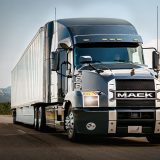- Maximize your heavy-duty truck’s range by mastering regenerative braking, driving smoothly under load, and planning routes strategically to handle heavy freight efficiently.
- Discover how efficient cabin temperature control and the latest advancements in battery technology can extend the range of your heavy-duty electric trucks, even in extreme weather conditions.
- Learn why speed management and optimized charging stops are critical for maximizing the range of heavy-duty electric trucks on long hauls.
Maximizing Heavy-Duty Electric Truck Range: Key Insights and Latest Strategies

Maximizing your truck’s range starts with mastering regenerative braking and optimizing every downhill opportunity. (Navistar Electric Truck)
Maximizing the range of Heavy-Duty electric trucks is critical for the efficiency and sustainability of the transportation industry. By mastering key factors such as regenerative braking, strategic route planning, speed management, and battery health, fleet operators can extend the range and performance of these trucks. This guide dives deep into updated strategies and technological developments specifically for heavy-duty electric trucks, designed to optimize fleet performance and increase efficiency. For more insights on the latest electric truck innovations, visit this page.
Effective Techniques for Enhanced Battery Performance in Heavy-Duty Trucks

Strategic route planning for heavy-duty electric trucks can be the difference between maximizing efficiency and losing valuable energy.
Heavy-duty battery-electric trucks (BETs) are transforming freight and logistics by providing a sustainable alternative to diesel-powered trucks. However, their range can be affected by various factors, and understanding how to optimize these is crucial for efficient long-haul operations. To stay updated on battery-electric technology, explore this page.
How Does Regenerative Braking Maximize Heavy-Duty Electric Truck Range?
Regenerative braking is a critical tool in extending the range of heavy-duty electric trucks. By recovering energy during deceleration, kinetic energy is converted back into electrical energy stored in the battery. This system not only extends range but also reduces the need for traditional brake maintenance. In fact, studies have shown that using regenerative braking effectively can increase range by up to 35%.
”Implementing regenerative braking efficiently can save significant energy during long descents, especially in trucks carrying heavier payloads.”
Enjoying our insights?
Subscribe to our newsletter to keep up with the latest industry trends and developments.
Stay Informed
Leveraging Regenerative Braking for Freight Operations
- Optimize Long Descents for Energy Recovery: Freight routes with long descents present opportunities for heavy-duty trucks to recover substantial energy using regenerative braking, especially when carrying heavy payloads.
- Utilize One-Pedal Driving Features: Some heavy-duty trucks offer one-pedal driving modes, which further optimize the vehicle’s ability to decelerate without the need for manual braking.
- Monitor Energy Recuperation: Fleet management tools allow drivers and managers to track how much energy is being recovered through regenerative braking, ensuring maximum efficiency.
For more insights on fleet efficiency in heavy-duty trucks, check out this page.
Why Is Smart Route Planning Essential for Heavy-Duty Trucks?

Fleet managers who prioritize load distribution and energy-efficient HVAC systems can extend range and reduce operational costs. (Toyota and Kenworth Fuel Cell Electric Hydrogen Trucks Fleet)
Efficient route planning plays a significant role in maximizing the range of heavy-duty electric trucks. Unlike lighter consumer electric vehicles, heavy-duty trucks face more challenges with payloads and terrain, both of which impact battery performance.
Planning routes that consider elevation changes, load weights, and available charging stations is key to optimizing energy use. Advanced GPS systems can map out the most energy-efficient routes. To learn more about optimizing fleet management, explore this link.
Strategies for Efficient Route Planning in Freight
- Account for Load Distribution: Planning deliveries to drop off the heaviest loads first helps reduce the vehicle’s overall weight and conserve battery energy for the remainder of the route.
- Use Terrain-Optimized Routing: Fleet managers should consider routes with fewer inclines and more opportunities for downhill driving where regenerative braking can be used.
- Plan for Charging Stops: Utilizing advanced tools such as Tesla’s Energy app, fleet operators can plan charging stops that fit into their logistics schedule, ensuring that trucks maintain power throughout their routes.
Can Speed Management Improve Heavy-Duty Truck Range?

Utilizing preconditioning while charging can save significant battery life during long-haul trips. (Charging Volvo FM Electric Truck)
Speed management is a critical factor for conserving energy in heavy-duty electric trucks. High speeds increase aerodynamic drag, and when combined with heavy loads, this can rapidly deplete battery reserves.
Maintaining consistent speeds under 52 mph on highways can help reduce energy consumption and maximize the truck’s range. Learn more about the impact of aerodynamics on trucking efficiency by visiting this page.
Tips for Maintaining Optimal Speed in Freight Transport
- Follow Speed Recommendations: Keeping speeds below 52 mph (83 km/h) is recommended to reduce energy consumption, particularly on highways where aerodynamic drag has a significant impact.
- Utilize Cruise Control: Cruise control ensures consistent speeds on long hauls, eliminating the inefficiencies caused by constant speed changes, which are especially detrimental for heavy-duty electric trucks.
- Avoid Rapid Acceleration: While heavy-duty electric trucks excel in torque, rapid acceleration can drain battery life quickly. Gradual acceleration helps conserve energy.
Does Cabin Temperature Affect Electric Truck Battery Life?

Speed management is critical—keeping under 52 mph significantly reduces aerodynamic drag and conserves energy. (Volvo Electric Truck)
The HVAC systems in heavy-duty trucks have a considerable effect on battery life, particularly during long hauls where trucks may experience a wide range of temperatures.
Managing cabin temperature efficiently is essential to preserving battery life, especially when driving in extreme weather conditions.
Managing Cabin Temperature Efficiently in Freight Trucks
- Precondition the Cabin While Charging: Preconditioning while the truck is still charging can significantly conserve energy that would otherwise be used during the drive.
- Use Energy-Efficient Heating Methods: Fleet managers can reduce overall battery consumption by utilizing seat heaters and energy-efficient HVAC settings. This approach is particularly useful during cold-weather hauls.
- Monitor HVAC Usage via Fleet Systems: Many heavy-duty electric trucks come equipped with telematics that allow operators to track HVAC energy consumption, enabling managers to adjust settings for optimal performance.
Additional Considerations for Optimizing Battery Performance in Heavy-Duty Trucks

Regenerative braking isn’t just about extending range; it’s also about reducing wear on traditional braking systems.
Several technical and maintenance factors contribute to optimizing battery performance and extending the range of heavy-duty electric trucks.
Regular Maintenance and Battery Management
- Battery Health Monitoring: Heavy-duty trucks from manufacturers such as Volvo include multiple large battery packs that offer up to 275 miles of range. Regular monitoring of battery health can prevent performance degradation, ensuring long-term efficiency.
- Tire and Aerodynamic Maintenance: Proper tire inflation and the use of aerodynamic enhancements, such as wheel covers and trailer skirts, can significantly reduce energy consumption on long-haul trips.
- Software Updates: Keeping fleet management software up-to-date ensures that trucks are operating with the latest battery and energy optimization algorithms, further extending their range.
To dive deeper into strategies for improving operational efficiency, check out this page.
Frequently Asked Questions About Maximizing Heavy-Duty Electric Truck Range
- How Does Regenerative Braking Impact Maintenance Costs for Heavy-Duty Trucks? Regenerative braking reduces wear on traditional brake systems, extending the lifespan of brake components and reducing overall maintenance costs.
- What Are the Latest Advancements in Battery Technology for Heavy-Duty Trucks? Recent developments have increased the range of heavy-duty electric trucks to 275 miles. Moreover, remanufacturing battery packs is emerging as a viable option to extend the lifecycle of these batteries.
- Can Aerodynamic Features Really Improve Range for Heavy-Duty Trucks? Yes, aerodynamic features such as wheel covers, fairings, and trailer skirts significantly reduce drag and improve range, especially at highway speeds.
Conclusion: Achieving Optimal Performance for Heavy-Duty Electric Trucks

Heavy-duty electric trucks require a blend of efficient driving techniques, careful route planning, and constant battery monitoring for optimal performance.
Maximizing the range of heavy-duty electric trucks requires a combination of efficient driving techniques, strategic route planning, and effective energy management. By leveraging regenerative braking, maintaining consistent speeds, and optimizing HVAC usage, fleet operators can extend battery performance and reduce range anxiety. With ongoing advancements in technology, heavy-duty electric trucks will continue to play a pivotal role in sustainable transportation.
Key Developments in HD Electric Truck Efficiency
Key Developments in HD Electric Truck Optimization:
- Regenerative Braking Efficiency: Implementing regenerative braking can extend range by up to 35%, particularly on downhill routes and during coasting.
- Advanced Route Planning Tools: Utilize GPS systems that account for elevation and terrain to reduce energy consumption and maximize range.
- Battery Lifespan Improvements: New battery technologies now offer extended ranges up to 275 miles and maintain 80% capacity even after 8 years of use.
Discover the Latest Innovations and Transformations in Electric Trucking
- Volvo Electric Trucks Funding Soars: $208 Million Boost
Discover how Volvo secured $208 million from the U.S. Energy Department to fast-track the production of heavy-duty electric vehicles. - Sysco Orders 800 Electric Trucks
Sysco Corporation is electrifying 35% of its U.S. fleet by 2030, with plans to deploy up to 800 Freightliner eCascadia electric trucks by 2026. - US Foods Electric Trucks Transform Fleet
Learn how US Foods is deploying 30 electric trucks in California and collaborating with NextEra to build charging infrastructure. - Port Adds Electric Trucks
Shippers Transport Express integrates 10 Peterbilt electric trucks into its drayage operations at the Port of Oakland. - Zeem Buying 100 Electric Vehicles
Zeem Solutions purchases 100 Nikola Class 8 battery-electric trucks for its all-inclusive EV depot fleet solution.
Explore External Resources on Maximizing Heavy-Duty Electric Truck Range
To complement our article, we’ve curated a list of external resources that provide additional insights into heavy-duty electric truck range optimization, technological advancements, and real-world applications.
- IEA: Global Trends in Electric Heavy-Duty Vehicles: For a global perspective, review electric heavy-duty vehicle trends and market statistics, highlighting how different regions are advancing in the electrification of transportation, at IEA.
- NREL: EV Charging and Grid Integration for Heavy-Duty Fleets: Grid integration is essential for the future of electric trucks. Discover NREL’s research into depot charging solutions and how existing infrastructure can support fleet electrification at NREL.
- Volvo Trucks: How to Maximize an Electric Truck’s Range: Volvo is a leader in the electric truck space. Dive into their expert strategies for extending electric truck range using advanced technologies, such as regenerative braking, at Volvo Trucks.
- Tesla Semi Range Optimization: The Tesla Semi shows remarkable range and performance benefits over traditional trucks. Learn how Tesla’s energy management and regenerative braking systems help boost range at Tesla.
- Navistar eMV Series and ePTO Options: Navistar’s eMV Series includes ePTO systems that pull power from the truck’s battery for external systems, optimizing overall energy use. Read more at International Trucks.





















